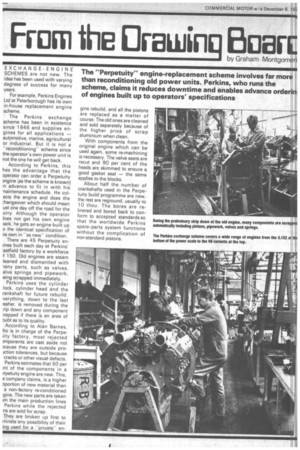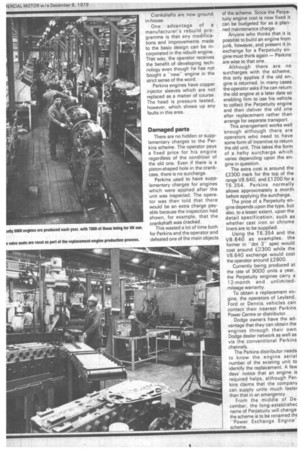From the Drawing BOER
Page 46

Page 47

If you've noticed an error in this article please click here to report it so we can fix it.
by Graham Montgomeri The "Perpetuity" engine-replacement scheme involves far more than reconditioning old power units. Perkins, who runs the scheme, claims it reduces downtime and enables advance orderini of engines built up to operators' specifications
EXCHANGE-ENGINE SCHEMES are not new. The idea has been used with varying degrees of success for many years.
For example, Perkins Engines Ltd at Peterborough has its own in-house replacement engine scheme.
The Perkins exchange scheme has been in existence since 1946 and supplies engines for all applications — automotive, marine, agricultural or industrial. But it is not a -reconditioningscheme since the operator's own power unit is not the one he will get back. According to Perkins, this has the advantage that the operator can order a Perpetuity ngine Os the scheme is known) In advance to fit in with his maintenance schedule. He colects the engine and does the 1:hangeover which should mean ust one day off the road for the orry. Although the operator ioes not get his own engine )ack, he gets an engine built up o the identical specification of us own in "as new' condition. There are 45 Perpetuity enlines built each day at Perkins' :astfield factory by a workforce f 150. Old engines are steam leaned and dismantled with any parts, such as valves, alve springs and pipework, leing scrapped immediately. Perkins uses the cylinder lock, cylinder head and the rankshaft for future rebuild. verything, down to the last tasher, is removed during the :rip down and any component 3rapped if there is an area of u bt as to its quality. According to Alan Barnes, ho is in charge of the Perpelity factory, most rejected )mponents are cast aside not 3cause they are outside proJction tolerances, but because cracks or other visual defects. Perkins estimates that 50 per !nt of the components in a rpetuity engine are new. This, e company claims, is a higher °portion of new material than a non-factory re-conditioned gine. The new parts are taken urn the main production lines Perkins while the rejected rts are sold for scrap.
They are broken up first to minate any possibility of their ing used for a "'privateen
gine rebuild, and all the pistons are replaced as a matter of course. The old ones are cleaned and sold separately because of the higher price of scrap aluminium when clean.
With components from the original engine which can be used again, some re-machining is necessary. The valve seats are recut and 90 per cent of the heads are skimmed to ensure a good gasket seal — the same applies to the blocks.
About half the number of crankshafts used in the Perpetuity build programme are new, the rest are reground, usually to 10 thou, The bores are relinered and bored back to conform to accepted standards so that the worldwide Perkins spare-parts system functions without the complication of non-standard pistons.
Crankshafts are now ground in-house.
One advantage of a manufacturer's rebuild programme is that any modifications and improvements made to the basic design can be incorporated in the rebuilt engine. That way, the operator receives the benefit of developing technology even though he has not bought a "new" engine in the strict sense of the word.
Perkins engines have copper injector sleeves which are not replaced as a matter of course. The head is pressure tested, however, which shows up any faults in this area
Damaged parts
There are no hidden or supplementary charges to the Perkins scheme. The operator pays a fixed price for his engine regardless of the condition of the old one. Even if there is a piston-shaped hole in the crankcase, there is no surcharge.
Perkins used to have supplementary charges for engines which were applied after the unit was inspected. The operator was then told that there would be an extra charge payable because the inspection had shown, for example, that the crankshaft was cracked.
This wasted a lot of time both for Perkins and the operator and defeated one of the main objects of the scheme. Since the Perpetuity engine cost is now fixed it can be budgeted for as a planned maintenance charge.
Anyone who thinks that it is possible to build an engine from junk, however, and present it in exchange for a Perpetuity engine must think again — Perkins are wise to that one.
Although there are no surcharges with the scheme, this only applies if the old engine is returned. In many cases the operator asks if he can return the old engine at a later date so enabling him to use his vehicle to collect the Perpetuity engine and then deliver the old one after replacement rather than arrange for separate transport.
This arrangement works well enough although there are operators who need to have some form of incentive to return the old unit. This takes the form of a hefty surcharge which varies depending upon the engine in question.
The extra c:ost is around the £2300 mark for the top of the range V8.640, and £1200 for a T6.354, Perkins normally allows approxiimately a month before applying the surcharge.
The price of a Perpetuity engine depends upon the type, but also, to a lesser extent, upon the detail specification; such as whether cast iron or chrome liners are to be supplied.
Using the T6.354 and the V8.640 as examples, the former in "dot 3spec would cost around £2300 while the V8.640 exchange would cost the operator around £2900.
Currently being produced at the rate of 9000 units a year, the Perpetuity engines carry a 12-month arid unlimitedmileage warranty.
To obtain a replacement engine, the operators of Leyland, Ford or Dennis. vehicles can contact their nearest Perkins Power Centre or distributor.
Dodge owners have the advantage that they can obtain the engines through their own Dodge dealer network as well as via the conventional Perkins channels.
The Perkins distributor needs to know the engine serial number of the existing unit to identify the replacement. A few days' notice that an engine is required helps, although Perkins claims that the company can supply units much faster than that in an emergency.
From the middle of Decamber, the long-establishec name of Perpetuity will change the scheme is to be renamed thE 'Power Exchange Engine' scheme.
























































































































































